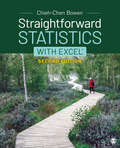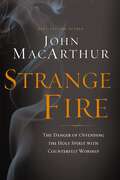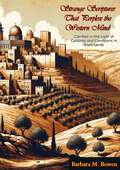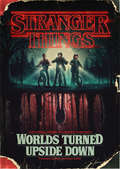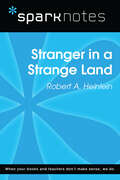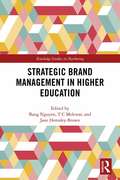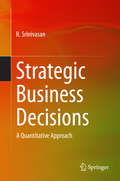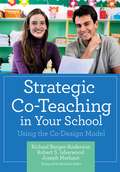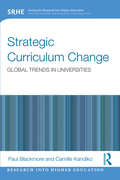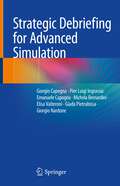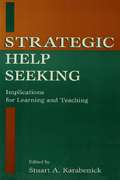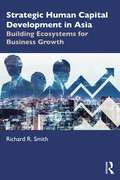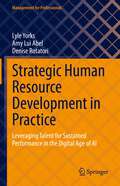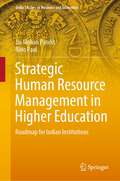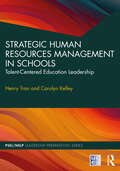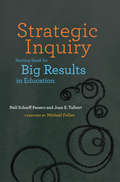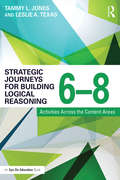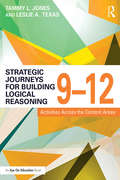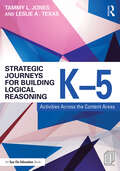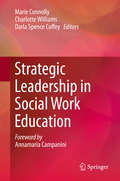- Table View
- List View
Straightforward Statistics with Excel®
by Chieh-Chen BowenWritten in an accessible and clear manner, Straightforward Statistics with Excel® 2e by Chieh-Chen Bowen helps students across the social and behavioral sciences gradually build their skills to develop a better understanding of the world around them. Each chapter purposefully connects with the previous chapter for a gradual accrual of knowledge from simple to more complex concepts. This effective, cumulative approach to statistics through logical transitions eases students into statistics and prepares them for success in more advanced quantitative coursework and their own research. The second edition now features Excel instructions and exercises throughout so students can use this widely-available and applied software for statistics. This book is designed to walk the reader through statistics at a steady but gentle pace, providing pop quizzes throughout every chapter so readers can check their knowledge along the way. By gradually stepping up difficulty in each chapter, students generate a solid foundation and are prepared for the next chapters. Straightforward Statistics with Excel looks at the big picture so that the basic statistical concepts connect to everyday and relevant research examples in multiple ways. Throughout the book the reader is reminded of what they need to be able to recall with "You Must Remember This" boxes. A rich source of practical resources are located at the end of chapters beginning with " What You Learned," followed by three sets of exercises so students can immediately apply their knowledge. The new edition features a reorganized presentation of material, starting with measures of central tendency, separating this from measures of variability so students better understand the differences. A more thorough presentation of one-sample and dependent samples t-tests gives students a stronger foundation in these crucial tests in statistics. New examples and studies complete the update, with a focus on simplicity. Throughout, the book makes use of Excel instructions and screenshots so students can take statistics with them through research projects and into the world beyond academia.
Straightforward Statistics with Excel®
by Chieh-Chen BowenWritten in an accessible and clear manner, Straightforward Statistics with Excel® 2e by Chieh-Chen Bowen helps students across the social and behavioral sciences gradually build their skills to develop a better understanding of the world around them. Each chapter purposefully connects with the previous chapter for a gradual accrual of knowledge from simple to more complex concepts. This effective, cumulative approach to statistics through logical transitions eases students into statistics and prepares them for success in more advanced quantitative coursework and their own research. The second edition now features Excel instructions and exercises throughout so students can use this widely-available and applied software for statistics. This book is designed to walk the reader through statistics at a steady but gentle pace, providing pop quizzes throughout every chapter so readers can check their knowledge along the way. By gradually stepping up difficulty in each chapter, students generate a solid foundation and are prepared for the next chapters. Straightforward Statistics with Excel looks at the big picture so that the basic statistical concepts connect to everyday and relevant research examples in multiple ways. Throughout the book the reader is reminded of what they need to be able to recall with "You Must Remember This" boxes. A rich source of practical resources are located at the end of chapters beginning with " What You Learned," followed by three sets of exercises so students can immediately apply their knowledge. The new edition features a reorganized presentation of material, starting with measures of central tendency, separating this from measures of variability so students better understand the differences. A more thorough presentation of one-sample and dependent samples t-tests gives students a stronger foundation in these crucial tests in statistics. New examples and studies complete the update, with a focus on simplicity. Throughout, the book makes use of Excel instructions and screenshots so students can take statistics with them through research projects and into the world beyond academia.
Stranded in Space (Into Reading, Level S #55)
by Dede Putra Michael PryorNIMAC-sourced textbook. Trina and her family are on a long journey through space to their new home on the planet Bounty, when they have to evacuate their damaged ship. Trina's escape pod spins off course, and she finds herself stranded on Epsilon Gamma, a planet made up of tropical islands. All by herself, Trina has to make a shelter, find food, and keep out of danger—but is she really alone?
Strange Fire: The Danger of Offending the Holy Spirit with Counterfeit Worship
by John F. MacArthurIn Strange Fire, bestselling author and pastor John MacArthur chronicles the unsavory history behind the modern Charismatic movement.What would God say about those who blatantly misrepresent His Holy Spirit; who exchange true worship for chaotic fits of mindless ecstasy; who replace the biblical gospel with vain illusions of health and wealth; who claim to prophesy in His name yet speak errors; and who sell false hope to desperate people for millions of dollars?The charismatic movement has always been a breeding-ground for scandal, greed, bad doctrine, and all kinds of spiritual chicanery. As a movement, it is clearly headed the wrong direction. And it is growing at an unprecedented rate.From the Word of Faith to the New Apostolic Reformation, the Charismatic movement is being consumed by the empty promises of the prosperity gospel. Too many charismatic celebrities promote a &“Christianity&” without Christ, a Holy Spirit without holiness. And their teaching is having a disastrous influence on a grand scale, as large television networks broadcast their heresies to every part of the world.In Strange Fire, MacArthur lays out a chilling case against the modern Charismatic movement that includes:Rejecting its false prophets.Speaking out against their errors.Showing true reverence to the Holy Spirit.Clinging to the Bible as the inerrant, authoritative Word of God and the one true standard by which all truth claims must be tested.
Strange Scriptures That Perplex the Western Mind: Clarified in the Light of Customs and Conditions in Bible Lands
by Barbara M. BowenDelve into the intriguing world of biblical interpretation with Barbara M. Bowen's Strange Scriptures That Perplex the Western Mind. This enlightening book offers readers a comprehensive guide to understanding the cultural, historical, and linguistic contexts of various biblical passages that often confuse or perplex modern Western readers.Barbara M. Bowen, an esteemed biblical scholar and educator, provides a detailed exploration of scriptures that seem mysterious or contradictory when viewed through a contemporary Western lens. By shedding light on the ancient customs, traditions, and idiomatic expressions of the times, Bowen reveals the true meanings and profound wisdom contained within these passages.Strange Scriptures That Perplex the Western Mind covers a wide range of topics, including enigmatic sayings, puzzling parables, and complex metaphors found in both the Old and New Testaments. Bowen's accessible and engaging writing style makes these ancient texts come alive, offering readers new insights and a deeper appreciation for the richness of the biblical narrative.The book is organized thematically, making it easy for readers to navigate and find explanations for specific passages that have long puzzled them. Bowen's thorough research and thoughtful analysis provide clear and concise interpretations that bridge the gap between ancient and modern understanding.This book is an invaluable resource for anyone seeking to deepen their understanding of the Bible, whether they are students of theology, clergy, or lay readers. Strange Scriptures That Perplex the Western Mind not only clarifies confusing passages but also enriches the reader's overall comprehension of the Bible's message and its relevance to contemporary life.
Stranger Online (TodaysGirls.com #1)
by Carol Smith Terry BrownMeet Amber. Mysterious, threatening emails end up in Amber's mailbox in her mailbox on the girls Web site. But only the Today'sGirls know about their new site! Suddenly, the stranger logs on during a routine nightly chat session. Who could this sixth person be? Amber's integrity -- and her spot on the swim team -- is called into question before she manages to solve the mystery and save her reputation.
Stranger Things: The Official Behind-the-Scenes Companion
by Gina McIntyre Matt Duffer Ross DufferThe official behind-the-scenes companion guide to the first two seasons of Stranger Things and beyond, brought to life with exclusive photos and stunning concept art. Stranger things have happened. . . . When the first season of Stranger Things debuted on Netflix in the summer of 2016, the show struck a nerve with millions of viewers worldwide and received broad critical acclaim. The series has gone on to win six Emmy Awards, but the its success was driven more than anything by word of mouth, resonating across generations. Viewers feel personal connections to the characters. Now fans can immerse themselves in the world—or worlds—of Hawkins, Indiana, like never before. Inside you’ll find • original commentary and a foreword from creators Matt and Ross Duffer • exclusive interviews with the stars of the show, including Millie Bobby Brown, Finn Wolfhard, and David Harbour • the show’s earliest drafts, pitches to Netflix, and casting calls • insights into the Duffers’ creative process from the entire crew—from costume and set designers to composers and visual-effects specialists • deep dives into the cultural artifacts and references that inspired the look and feel of the show • a map of everyday Hawkins—with clues charting the network of the Upside Down • a digital copy of the Morse code disk Eleven uses, so you can decipher secret messages embedded throughout the text • a look into the future of the series—including a sneak preview of season three! Adding whole new layers to enrich the viewing experience, this keepsake is essential reading for anyone and everyone who loves Stranger Things. Note: This ebook is best viewed on a color device with a larger screen.
Stranger in a Strange Land (SparkNotes Literature Guide Series)
by SparkNotesStranger in a Strange Land (SparkNotes Literature Guide) by Robert A. Heinlein Making the reading experience fun! Created by Harvard students for students everywhere, SparkNotes is a new breed of study guide: smarter, better, faster. Geared to what today's students need to know, SparkNotes provide: *Chapter-by-chapter analysis *Explanations of key themes, motifs, and symbols*A review quiz and essay topicsLively and accessible, these guides are perfect for late-night studying and writing papers.
Strategic Brand Management in Higher Education (Routledge Studies in Marketing)
by Bang Nguyen Jane Hemsley-Brown T. C MelewarUniversity branding has increased substantially, due to demands on universities to enrol greater numbers of students, rising tuition fees, the proliferation of courses, the growing 'internationalization' of universities, financial pressures, and reliance on income from foreign students. As higher education continues to grow, increased competition places more pressure on institutions to market their programs. Technological, social, and economic changes have necessitated a customer-oriented marketing system and a focus on developing the university brand.This book is unique in providing a composite overview of strategy, planning, and measurement informed by ground-breaking research and the experiences of academics. It combines theoretical and methodological aspects of branding with the views of leading exponents of branding in different contexts and across a range of higher education institutions. Expert contributors from research and practice provide relevant and varying perspectives allowing readers to access information on international trends, theory, and practices about branding in higher education.Readers are exposed to the critical elements of strategic brand management, gain insights into the planning process of higher education branding, and gain a solid understanding of the emerging research area of branding concepts in higher education. Advanced students, and researchers will find this book a unique resource and it will also be of interest to brand practitioners in both education and public sector markets.
Strategic Business Decisions
by R. SrinivasanThis book presents the essential concepts of operations research and engineering management in a structured manner. Starting with the basic functions of management - planning, organizing, leading and controlling - it introduces the reader to the process of strategic decision-making, covering the essentials of technological invention management, innovation and entrepreneurship, with ample examples of decision-making under certainty, uncertainty and risk conditions. It also exposes the reader to the fundamentals of managing projects and professional communication. In order to reinforce the theory used, practical case studies taken from relevant disciplines are introduced. For instance, case studies from the retail sector have been appended to the assignment problem and cases related to traffic have been introduced for queuing formulation. The concept of game theory is discussed in greater detail with an introduction to topics such as incentive compatibility, Bayesian representations for different games, budget balance, auctions and a broad coverage of mechanism design. While a few of these problems have been solved in the book, a few others have been left un-solved to promote readers' understanding. The mix of theoretical and practical examples reveals to the reader the underlying complexities and highlights the challenges entailed by field implementation.
Strategic Co-teaching In Your School: Using The Co-design Model
by Michelle Miller Richael Barger-Anderson Robert S. Isherwood Joseph MerhautAs a school leader, you probably know about the benefits of co-teaching in inclusive classrooms—and maybe your school already puts it into practice. Now there's a book that helps your school take collaborative teaching and learning to the next level, so educators benefit from each other's expertise and all students succeed and meet their goals. <p><p> This book gives you a detailed, step-by-step guide to the research-based Co-Design Model, an innovative, schoolwide approach used in districts nationwide to strengthen collaboration and inclusion. Going far beyond typical co-teaching models focused only on instruction, the proven Co-Design Model works because it targets nine areas essential to inclusive, collaborative education.
Strategic Curriculum Change in Universities: Global Trends (Research into Higher Education)
by Paul Blackmore Camille B. KandikoThe curriculum is a live issue in universities across the world. Many stakeholders – governments, employers, professional and disciplinary groups and parents – express strong and often conflicting views about what higher education should achieve for its students. Many universities are reviewing their curricula at an institutional level, aware that they are in a competitive climate in which league tables encourage students to see themselves as consumers and the university as a product, or even a ‘brand’. The move has prompted renewed concern for some central educational questions, about both what is learnt and how. Strategic Curriculum Change explores the ways in which major universities across the world are reviewing their approaches to teaching and learning. It unites institution-level strategy with the underlying educational issues. The book is grounded in a major study of curriculum change in over twenty internationally-focused, research-intensive universities in the UK, US, Australia, The Netherlands, South Africa and Hong Kong. Chapters include: Achieving curriculum coherence: Curriculum design and delivery as social practice Assessment in curriculum change The whole-of-institution curriculum renewal undertaken by the University of Melbourne, 2005-2011 The physical and virtual environment for learning People and change: Academic work and leadership This book presents a theorised and contextualised approach to the study of the curriculum, and carries on much-needed research on the curriculum in higher education. It is an essential for the collection of all academics at university level, and those involved in policy making, quality assurance and enhancement.
Strategic Debriefing for Advanced Simulation
by Giorgio Capogna Giada Pietrabissa Giorgio Nardone Elisa Valteroni Pier Luigi Ingrassia Emanuele Capogna Michela BernardiniThis book provides an in-depth and complete guide explaining how to incorporate the strategic dialogue and strategic communication methods into the debriefing after the scenario, characteristics that make it unique. After examining all the aspects that allow a correct use of the simulation, such as knowledge of models, logical schemes, use of the different simulators, planning of the didactic activities and of learning process, this practical book aims to explore the advanced technique of the strategic debriefing. It encourages not only those who are approaching this new debriefing tool but also it provides a useful update to all those who are already more familiar with the standard debriefing after simulation technique.The strategic language, an effective tool in strategic psychotherapy and business problem solving, is ideal and complementary to the standard debriefing methods, making them more performing and functional because, next to common logic, it makes use of non-ordinary logical language. The book is intended for healthcare simulation debriefers and instructors, for hospitals’ managers, university teachers and to all the physicians who are increasingly showing interest in active teaching processes with simulation.
Strategic Diversity Leadership: Activating Change and Transformation in Higher Education
by Damon A. WilliamsIn today’s world – whether viewed through a lens of educational attainment, economic development, global competitiveness, leadership capacity, or social justice and equity – diversity is not just the right thing to do, it is the only thing to do! Following the era of civil rights in the 1960s and ‘70s, the 1990s and early 21st century have seen both retrenchment and backlash years, but also a growing recognition, particularly in business and the military, that we have to educate and develop the capacities of our citizens from all levels of society and all demographic and social groups to live fulfilling lives in an inter-connected globe.For higher education that means not only increasing the numbers of diverse students, faculty, and staff, but simultaneously pursuing excellence in student learning and development, as well as through research and scholarship – in other words pursuing what this book defines as strategic diversity leadership. The aim is to create systems that enable every student, faculty, and staff member to thrive and achieve to maximum potential within a diversity framework. This book is written from the perspective that diversity work is best approached as an intellectual endeavor with a pragmatic focus on achieving results that takes an evidence-based approach to operationalizing diversity. It offers an overarching conceptual framework for pursuing diversity in a national and international context; delineates and describes the competencies, knowledge and skills needed to take effective leadership in matters of diversity; offers new data about related practices in higher education; and presents and evaluates a range of strategies, organizational structures and models drawn from institutions of all types and sizes. It covers such issues as the reorganization of the existing diversity infrastructure, building accountability systems, assessing the diversity process, and addressing legal threats to implementation. Its purpose is to help strategic diversity leaders combine big-picture thinking with an on-the-ground understanding of organizational reality and work strategically with key stakeholders and allies. This book is intended for presidents, provosts, chief diversity officers or diversity professionals, and anyone who wants to champion diversity and embed its objectives on his or her campus, whether at the level of senior administration, as members of campus organizations or committees, or as faculty, student affairs professionals or students taking a leadership role in making and studying the process of change.This title is also available in a set with its companion volume, The Chief Diversity Officer.
Strategic Help Seeking: Implications for Learning and Teaching
by Stuart A. KarabenickThere is considerable agreement that more successful learners are active, engaged, and self-regulating learners who understand and are motivated to apply learning strategies under appropriate conditions. One important strategic activity is seeking help when necessary, rather than giving up or engaging in fruitless persistence. Research on strategic help seeking has matured significantly in recent years. This volume captures the current state of knowledge, research, and theory on help seeking as a strategic learning resource. It is international in scope, with contributors from the U.S., the Netherlands, Japan, and Israel. As a whole, the book suggests that strategic (adaptive) help seeking is a critical school readiness skill that is facilitated by mastery-oriented classroom achievement and social goals, by teachers who invite questions rather than those who ask them, and by cultural characteristics that support student inquiry. A conceptual overview is followed by three chapters that examine help seeking from complementary theoretical perspectives and make important distinctions between forms of help seeking; two chapters that focus on how learners' achievement and social goals affect classroom help seeking; one chapter specifically devoted to cross-cultural comparisons of help seeking in Western cultures and in Japan; two chapters that examine the most frequent manifestation of help seeking--that of question asking; and one chapter that explores help-seeking in the information age (the library reference process, information technology, and computer-mediated communication). All chapters include attention to the implications of research and theory for help seeking in instructional settings. Strategic Help Seeking is an excellent resource for educational researchers and practitioners including teachers, school administrators, instructional designers, reference librarians.
Strategic Human Capital Development in Asia: Building Ecosystems for Business Growth
by Richard R. SmithAsia continues to ascend as an economic powerhouse and a strategic priority for business leaders around the world, yet there is often limited understanding of the human capital systems that fuel the economic engines of the region. This book brings together the perspectives from economics, sociology, and management to highlight the business implications of human capital development in Asia. This book provides new insights on human capital systems in Asia by considering the country context through a 'Human Capital Ecosystem' framework. Applying this framework, constituent outline, and comparable points across each of the countries in Asia, Smith translates national policies into insights on the drivers, challenges, and opportunities in individual countries. Each chapter also draws out clear business and HR implications based on the above framework and analysis. While Asia continues to be a critical priority for businesses, there is limited understanding on how to manage and navigate the human capital systems in each of the region’s diverse countries. This book will serve as a helpful reference for managers or supplemental study guide for graduate students working to understand how to execute business strategy in major economies of Asia.
Strategic Human Resource Development in Practice: Leveraging Talent for Sustained Performance in the Digital Age of AI (Management for Professionals)
by Lyle Yorks Amy Lui Abel Denise RotatoriThis book examines human resource development (HRD) strategy as a learning process, connecting learning and adult development with organizational development and change, and talent development, with a particular focus on the use of artificial intelligence (AI). It provides professionals and practitioners as well as students with processes and tools that will help them meet the needs of employees and the organization. It takes a scholar-practitioner perspective connecting theory with practice. HRD has evolved into a mature field of scholarship in recent decades. At the same time, practices of learning and development in organizations continues to evolve dramatically. At the individual, developmental, and organizational levels, workers, managers, and executives have to be continually learning from current and emerging trends in order to strategically reposition themselves for performance and future possibilities. This includes developing the competencies to navigate the complexities of a world in which people are interacting with ‘smart’ digital technologies that are broadly grouped together under the umbrella term artificial intelligence (AI). Featuring specific strategic learning methods and case studies from senior HRD professionals, this book is a valuable resource for managers, practitioners, students, scholars and others interested in strategic HRD practice.
Strategic Human Resource Management in Higher Education: Roadmap for Indian Institutions (India Studies in Business and Economics)
by Jai Mohan Pandit Bino PaulThis book explores the practices and policies of human resource management (HRM) in higher education institutions (HEI), while also analyzing the governance and structural challenges. It explains the assessment of university as an organization, outlining the distinction between universities and firms from an HRM point of view by analysing various objectives, parameters and outcomes. The book broadly probes the relevance of HRM systems in HEIs in India and their potential impact. It also examines whether existing HRM practices and policies in HEIs in India drive motivation and enable employees to perform their functions to achieve the highest possible levels of excellence. It explores whether the enhanced motivation of employees consistently impacts students, their placements, progress to higher education, and quality teaching and research output. To strengthen the research output, to better understand the functioning of HRM practices in foreign HEIs and for comparative reasons, the book also studies HEIs in the United States against a diverse set of HEIs in India. It concludes by highlighting the impact of India’s National Education Policy 2020 and its scope to transform and professionalise the higher education system in the country. The book is indispensable for researchers in education management and policy studies and those in governing positions in higher education institutions. It is also a valuable resource for regulatory and government bodies, and policy-formulating think tanks in South Asia which have a similar education system as India.
Strategic Human Resources Management in Schools: Talent-Centered Education Leadership (PSEL/NELP Leadership Preparation)
by Carolyn Kelley Henry TranStrategic Human Resources Management in Schools provides a new approach to human resources management, grounded in the perspectives of cutting-edge practice, research, and theory. Traditional human resource (HR) practices in education have operated in an isolated and reactionary manner; this book explores an updated version of personnel administration that links strategic human resources to organizational goals, educational mission, educator well-being, and student success. Coverage includes exemplar strategic HR practices from progressive organizations and leading companies, discussion of tricky issues like discrimination and implicit bias, and developmental and humanistic support of teachers as well as support staff, including paraprofessionals, food service workers, and bus drivers. The Talent-Centered Education Leadership (TCEL) model presented in this book explores how educational leaders can create a nurturing and inclusive workplace for all educational staff, which is ultimately critical for improvement in student learning and strengthening recruitment and retention of a quality education workforce. Designed for aspiring leaders, this volume is grounded in the Professional Standards for Educational Leaders (PSEL) and National Educational Leadership Preparation (NELP) Building and District Level standards and is full of rich pedagogical features including cases, “warning boxes” to explore areas particularly thorny to navigate, questions for discussion, and various learning activities.
Strategic Inquiry: Starting Small for Big Results in Education
by Nell Scharff Panero Michael Fullman Joan E TalbertStrategic Inquiry is an innovative model for promoting teacher collaboration around identifying specific "learning gaps" that keep struggling students from succeeding. Gaps may include anything from the proper use of commas and conjunctions to concepts such as "slope" in math. The authors argue that addressing these critical learning gaps can lead to big changes in student success, in teachers' sense of efficacy, and in school culture. The strategic inquiry model has been implemented in schools and districts around the country, including New York City, where it was rigorously evaluated with impressive results. As Common Core standards raise the bar for student learning ever higher, this proven approach promises to build teachers' capacity for closing the gap between where struggling students are and where they need to be."
Strategic Inquiry: Starting Small for Big Results in Education
by Nell Scharff Panero Joan E TalbertStrategic Inquiry is an innovative model for promoting teacher collaboration around identifying specific &“learning gaps&” that keep struggling students from succeeding. Gaps may include anything from the proper use of commas and conjunctions to concepts such as &“slope&” in math. The authors argue that addressing these critical learning gaps can lead to big changes in student success, in teachers&’ sense of efficacy, and in school culture. The strategic inquiry model has been implemented in schools and districts around the country, including New York City, where it was rigorously evaluated with impressive results. As Common Core standards raise the bar for student learning ever higher, this proven approach promises to build teachers&’ capacity for closing the gap between where struggling students are and where they need to be."
Strategic Journeys for Building Logical Reasoning, 6-8: Activities Across the Content Areas (Strategic Journeys Series)
by Tammy Jones Leslie TexasHelp your students develop logical reasoning and critical thinking skills. This new book from bestselling authors and popular consultants Tammy Jones and Leslie Texas offers authentic logic-building activities and writing strategies that can be used across all subject areas in grades 6-8. Filled with hands-on activities and photocopiable tools, Strategic Journeys will help you guide your students into deeper thinking to go beyond the surface of content to true understanding. Topics include: Identifying opportunities for students to engage in meaningful and relevant writing across the content areas; Introducing a logical reasoning process, questioning structure, and bridging models to allow students to delve deeper into problems; Incorporating literature to increase student engagement and make content come alive for your students; Building vocabulary and literacy skills through fun activities aimed at increasing proficiency; Using the Three Phases of Logical Reasoning to plan lessons effectively, help students reflect on their progress, and implement the strategies successfully. The strategies in this book have been implemented in hundreds of classrooms around the country, and have been proven to increase student engagement, promote higher-order thinking and in-depth reasoning, and improve overall achievement.
Strategic Journeys for Building Logical Reasoning, 9-12: Activities Across the Content Areas (Strategic Journeys Series)
by Tammy Jones Leslie TexasHelp your students develop logical reasoning and critical thinking skills. This new book from bestselling authors and popular consultants Tammy Jones and Leslie Texas offers authentic logic-building activities and writing strategies that can be used across all subject areas in grades 9-12. Filled with hands-on activities and photocopiable tools, Strategic Journeys will help you guide your students into deeper thinking to go beyond the surface of content to true understanding. Topics include: Identifying opportunities for students to engage in meaningful and relevant writing across the content areas; Introducing a logical reasoning process, questioning structure, and bridging models to allow students to delve deeper into problems; Incorporating literature to increase student engagement and make content come alive for your students; Building vocabulary and literacy skills through fun activities aimed at increasing proficiency; Using the Three Phases of Logical Reasoning to plan lessons effectively, help students reflect on their progress, and implement the strategies successfully. The strategies in this book have been implemented in hundreds of classrooms around the country, and have been proven to increase student engagement, promote higher-order thinking and in-depth reasoning, and improve overall achievement.
Strategic Journeys for Building Logical Reasoning, K-5: Activities Across the Content Areas (Strategic Journeys Series)
by Tammy Jones Leslie TexasHelp your students develop logical reasoning and critical thinking skills. This new book from bestselling authors and popular consultants Tammy Jones and Leslie Texas offers authentic logic-building activities and writing strategies that can be used across all subject areas in grades K–5. Filled with hands-on activities and photocopiable tools, Strategic Journeys will help you guide students into deeper thinking to go beyond the surface of content to true understanding. Topics include: Identifying opportunities for students to engage in meaningful and relevant writing across the content areas; Introducing a logical reasoning process, questioning structure, and bridging models to allow students to delve deeper into problems; Incorporating literature to increase student engagement and make content come alive for your students; Building vocabulary and literacy skills through fun activities aimed at increasing proficiency; Using the Three Phases of Logical Reasoning to plan lessons effectively, help students reflect on their progress, and implement the strategies successfully. The strategies in this book have been implemented in hundreds of classrooms around the country, and have been proven to increase student engagement, promote higher-order thinking and in-depth reasoning, and improve overall achievement.
Strategic Leadership in Social Work Education
by Marie Connolly Charlotte Williams Darla Spence CoffeySocial work leaders constantly strive to incorporate cutting-edge research and promote international collaboration in a dynamic contemporary environment. To address these ongoing concerns, this unique book focuses specifically on strategic leadership, asking critical questions about change-making, political strategy, and the opportunities that present themselves to lead new directions in social work education. Among the topics covered: Disruptive agendas and research dialogues in social work education Diversity leadership and perspectives beyond the mainstream The role of international bodies in advancing social work education Intellectual leadership and anticipating future advances in teaching strategies Democratising social work education Collaborative leadership models Strategic Leadership in Social Work Education examines the ability of social work to shape futures through education, training, and effective leadership, and suggests strategies for advancing responsible social work education in order to best meet tomorrow’s needs and aspirations.
